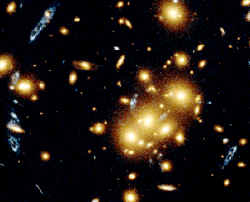A New Lens on Dark Matter

Astronomers can’t see it, but they know that it’s out there and that its gravity may hold the Universe together. It’s dark matter. In the 29 March PRL, two astrophysicists argue that the cosmic microwave background (CMB) radiation–the leftover glow of the big bang–may contain telltale imprints of the unseen dark matter. They predict that high resolution maps of the CMB to be recorded by a satellite in the next decade will reveal new details about the sizes of regions of dark matter in the Universe–information central to theories on the origin of galaxies and the large-scale structure of the Universe.
Like the woman who loses her keys in the dark but looks for them under a nearby lamppost, astronomers can only search where the light is. So dark matter can only be detected indirectly. One strategy, taken by the Sloan Digital Sky Survey, is to map all of the galaxies in the sky. Other researchers, noting the lack of proof that the light-emitting matter in galaxies traces dark matter, opt to use galaxies as background sources and then search the galaxies’ spectra for the effects of intervening material. Yet another camp, realizing that dark matter must exert a gravitational force on nearby galaxies, uses the observed velocities of galaxies to map the gravitational field of dark matter.
Uros Seljak of Princeton University and Matias Zaldarriaga of the Institute for Advanced Study in Princeton propose a new method: gravitational lensing of the CMB. Since light waves are bent as they travel through a gravitational field, large masses can act as lenses, distorting images of objects that are behind them. “It’s like looking through a wavy piece of glass,” explains Zaldarriaga. Recently astronomers have used gravitationally lensed images of far away galaxies to map the mass of nearby galaxy clusters. Seljak and Zaldarriaga argue that the same technique can be applied to the fluctuations in the CMB. When they were formed at the edge of the visible universe, these fluctuations were completely symmetric, but lensing by intervening dark matter should impart a statistically detectable distortion in the shapes of the fluctuations. Working back from the distortion, astronomers can reconstruct the spectrum of angular variations (power spectrum) in the dark matter. And since the CMB originates from shortly after the big bang and was transmitted through all of space and time between then and now, “our method can map the power spectrum of the entire Universe,” says Zaldarriaga.
Even with the unprecedented accuracy expected from the Planck satellite–which will map CMB fluctuations over the entire sky beginning in 2007–the statistical effects of the lensing will be difficult to separate from the background noise. “We will need a lot of peaks to get good statistics,” says Zaldarriaga. Scott Dodelson of the Fermi National Accelerator Laboratory in Illinois agrees. “They are looking for a needle in a haystack, but it is a very precious needle.”
–Mark Sincell
Mark Sincell is a freelance science writer based in Houston, TX.


